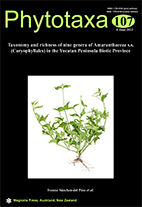Abstract
Amaranthaceae s.s. (Caryophyllales) is a cosmopolitan family well represented in the Yucatan Peninsula Biotic Province (YPBP). The YPBP is a biogeographic area that comprises entirely three Mexican states (Campeche, Quintana Roo, and Yucatan), partially two Mexican states (Chiapas and Tabasco), northern Belize, and northern Guatemala (Petén department). Most of the available checklists of the vascular plants from the Yucatan Peninsula (YP) merely include taxa from the Mexican states of Campeche, Quintana Roo, and Yucatan. A study of the Amaranthaceae diversity in the YPBP in its expanded delimitation is here presented for the first time, on the basis of field surveys and examinations of the specimens kept in the main Mexican herbaria (CICY, ENCB and MEXU). Accepted names, main synonyms, morphological descriptions, phenology, habitat, elevation, ethnobotanical uses, vernacular Spanish and Mayan names, origin status, and digital illustrations are provided for each taxon. Keys of identification are also given. Each taxon was geographically mapped using ArcGIS software. Notes about diversity and distribution analyses were conducted comparing maps of distribution for each taxon considering vegetation types and climatic types characterizing the YPBP. A total of 28 species (with 4 varieties) representing nine genera of Amaranthaceae s.s. (excluding Iresine) ocurring in the YPBP were studied. An estimate of the family diversity in the YPBP is increased here, as records of four new taxa are presented for this region. Results suggest that most of the taxa are natives, aliens, and/or weeds mostly occupying perturbed vegetation types. Only Blutaparon vermiculare, Amaranthus greggii, and A. arenicola show affinity to sand dunes primary vegetation. This new information about the distribution of Amaranthaceae s.s. in the YPBP, considering its invasion and origin status, can help to develop further studies focused on conservative approaching to know more about natural biogeographic regions such as YPBP.

